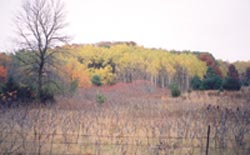 |
||||
      |
||||
|
A matter of trust As Heather Cegielski walks along the wooden fence framing her property near River Falls, she closes her eyes and slowly inhales the cool autumn air. With her hands tucked into the pockets of her oversized flannel coat, she smiles and listens to the birds loudly chirping in the tall oak and maple trees above. Leaves in luxurious hues of red and gold carpet the ground, crunching beneath her brown boots as she meanders through the piece of rural property she calls her dream. As the trees begin to thin and give way to a clearing, Cegielski suddenly stops. “There,” she says, gesturing with a sweep of her arm toward the land just on the other side of the worn fence. “This is why we bought this house.” The 350 acres of land spilling before her is nothing short of breathtaking. Prairie grasses softly blowing in the breeze melt into gently sloping hills dotted with evergreens and their autumn-hued deciduous counterparts. A crop of the rocky bluffs Western Wisconsin is famed for juts out against the horizon, the late afternoon’s blazing orange sun setting a stunning backdrop. Ahead, a brown tail is all that can be seen peeking from the tall native grasses before Cegielski’s 3-year-old chocolate lab, Bella, comes bounding toward her, wriggling with the sheer excitement of being free to roam through this piece of nature-lover’s paradise. Cegielski slowly leans down to pick up the stick Bella has dropped at her feet, then quickly throws it deep into the field before her. Watching Bella eagerly chase after her prize, she smiles and shakes her head. “Sometimes I just can’t believe how lucky we are to be living next to something like this,” Cegielski says. “And what’s even better is that we can go to bed at night knowing that this land will be here, untouched, for as long as we are.” That’s because in an era of urban sprawl, 25-year-old Cegielski and her 31-year-old husband, Kevin, happen to live next to a piece of land preserved through a land trust. Land trusts are non-profit, non-governmental conservation organizations that “actively work to protect natural resources through partnerships with private and public landowners,” according to the Web site of Gathering Waters Conservancy, one of 50 land trusts in Wisconsin. Combined, these 50 land trusts have worked to protect more than 60,000 acres of land in Wisconsin, according to Rick Gauger, executive director of the West Wisconsin Land Trust. As the largest land trust in Wisconsin, the West Wisconsin Land Trust alone has worked to protect more than 10,000 acres of land in the state. While each land trust operates slightly differently, Gauger says many land trusts, like his own, work primarily with private landowners in an effort to protect privately held land from development. Landowners who work with land trusts to preserve their property enter into a land-preservation agreement, which stipulates that their land may not be developed. Although this requires a serious commitment, Gauger says it has not stopped an increasing number of Wisconsinites from setting their property aside for conservation. “People live in Wisconsin and the Midwest because they enjoy the character of our state,” Gauger says. “It includes lakes, small farms, forests and the like. When people go driving right now, they see the leaves changing and the beauty that is Wisconsin. That’s why people live here. People are taking it into their own hands to preserve this land for generations to come. They’re not going to wait for the state or county to come up with zoning restrictions to stop development.” |
||
| Interactive map of land trusts | |||
|
|||
|
|||
